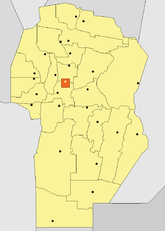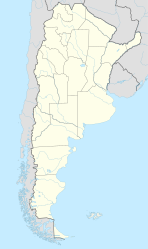Córdoba, Argentina
| Córdoba | ||
|---|---|---|
| City | ||
| Ciudad de Córdoba | ||

Clockwise from top: Cityscape taken from Naciones Park, San Martin Square, La Cañada Glen, Argentina Pavilion from National University of Córdoba, Cityscape at night taken from Nueva Cordoba neighborhood, Arch of Córdoba, Plaque commemorating the designation of the Jesuit block as World Heritage Site in 2000, Evita Fine Arts Museum.
|
||
|
||
 |
||
| Coordinates: 31°25′S 64°11′W / 31.417°S 64.183°WCoordinates: 31°25′S 64°11′W / 31.417°S 64.183°W | ||
| Country |
|
|
| Province |
|
|
| Department | Capital | |
| Established | 1573 | |
| Government | ||
| • Mayor | Ramón Javier Mestre (UCR) | |
| Area | ||
| • Land | 576 km2 (222 sq mi) | |
| Elevation | between 352 and 544 m (between 1,154.86 and 1,784.78 ft) | |
| Population (2008) | ||
| • City | 1,330,023 (census) | |
| • Density | 2,273.5/km2 (5,888.46/sq mi) | |
| • Metro | 1,528,000 (est) | |
| Time zone | ART (UTC−3) | |
| Córdoba Metropolitan area | |
|---|---|
 |
|
| Urban growth of Córdoba from 1573 to 2007 | |
| Population | 1,357,200 |
| Male population | 649,955 |
| Female population | 683,433 |
| Population growth | 1.0% |
| Birth rate | 19/1,000 |
| Death rate | 4.9/1,000 |
| Infant mortality rate | 18.1/1,000 |
| Life expectancy | 75.6 years |
Córdoba (Spanish pronunciation: [ˈkorðoβa]) is a city located in the geographical center of Argentina, in the foothills of the Sierras Chicas on the Suquía River, about 700 km (435 mi) northwest of the Autonomous City of Buenos Aires. It is the capital of Córdoba Province and the second most populous city in Argentina after Buenos Aires, with about 1,330,023 inhabitants according to the 2010 census. It was founded on 6 July 1573 by Jerónimo Luis de Cabrera, who named it after Córdoba, Spain. It was one of the first Spanish colonial capitals of the region that is now Argentina (the oldest city is Santiago del Estero, founded in 1553). The National University of Córdoba is the oldest university of the country and the second to be inaugurated in Latin America. It was founded in 1613 by the Jesuit Order. Because of this, Córdoba earned the nickname La Docta (roughly translated, "the learned one").
Córdoba has many historical monuments preserved from Spanish colonial rule, especially buildings of the Roman Catholic Church. The most recognizable is perhaps the Jesuit Block (Spanish: Manzana Jesuítica), declared in 2000 as a World Heritage Site by UNESCO which consists of a group of buildings dating from the 17th century, including the Colegio Nacional de Monserrat and the colonial university campus. The campus belongs today to the historical museum of the National University of Córdoba, which has been the second-largest university in the country since the early 20th century (after the University of Buenos Aires), in terms of the number of students, faculty, and academic programs. Córdoba is also known for its historical movements, such as Cordobazo and La Reforma del '18 (known as University Revolution in English).
...
Wikipedia


